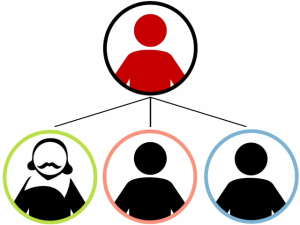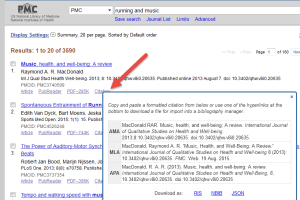6
Citations
Citations are the way in which you give credit to others for their work and avoid committing plagiarism. They are also the way in which you join the professional or scholarly conversation on a given topic.
Watch this short video to learn more about why citations are important.

Video credit: Citation: A (Very) Brief Introduction by NCSU Libraries, CC: BY-NC-SA 3.0 US
Citations come in two forms: in-text citations and full citations.
There are many different citation styles. Two of the most common academic styles are American Psychological Association (APA) and Modern Language Association (MLA). For academic assignments, your instructor will usually specify which style you should use. Generally speaking, MLA is used more frequently in the humanities, while APA is used more commonly in the social sciences and sciences. However, some subjects may have their own discipline-specific citation types, such as the American Society of Mechanical Engineers (ASME) style for the mechanical engineering field. Whatever style you choose or are asked to use, remember to stick with it consistently throughout your report.
In-text citations
In-text citations are used within the text of your paper and indicate to your readers from which source listed in your works cited or bibliography you are extracting information or quotations. That way, even if you have multiple sources, it is always clear which source you are using at any given time. As with full citations, discussed below, format of in-text citations differs depending on which citation style you are using. APA uses the author-year format, while MLA uses the author-page number format. Other styles of in-text citation include footnotes or endnotes, in which continuously sequenced numbers refer the reader to a list of citations elsewhere in the document. Some examples are below.
APA
Students should choose their study locations carefully for best results (Lei, 2015).
MLA
Students should choose their study locations carefully for best results (Lei 197).
In-text citations should always have a corresponding full citation on the works cited or references page at the end of a paper.
Full citations
Full citations generally have three major parts, though the order and formatting of these parts depends on the citation style you use.
Major parts
- Information about the person or body that created it – the author(s), editor(s), speaker(s), etc.
- Information that distinguishes the content of the specific work being cited – the title of an article, chapter, book, or presentation
- Information about the location or creation of the work – usually, where and when it was published or presented. This can include whether or not the work is part of a larger publication or series (volume and issue numbers), the number of printed pages it contains, or the web address (URL), and date it was accessed.
Below is an example of an article citation – the full citation for the in-text citation above – using MLA and APA styles. Notice the common elements that are present in both. You find the elements for a citation in the fields of a database or library catalog record or on the information item itself.
Author – Lei, Simon A.
Article Title – Variation in Study Patterns among College Students: A Review of Literature
Source Title – College Student Journal
Volume and Issue – Volume 49, Issue 2
Publication Date – 2015
Page Numbers – 195-198
APA
Lei, S. A. (2015). Variation in study patterns among college students: A review of literature. College Student Journal, 49(2), 195-198.
MLA
Lei, Simon A. “Variation in Study Patterns among College Students: A Review of Literature.” College Student Journal 49.2 (2015): 195-198. Academic Search Premier. Web. 19 Aug. 2015.
Luckily, you do not need to memorize citation style formats. There are excellent online guides and tools that will help you cite sources correctly. Additionally, you can always ask your instructor or a librarian for help if you have a question or a difficult source to cite.
Online guides and tools to consult:
- Purdue Online Writing Lab (OWL): Invaluable for MLA, APA, and Chicago styles, this guide covers in-text citations, bibliography/works cited pages, and guidelines for citing many types of information sources.
- Citation Builder: From the University of North Carolina, the Citation Builder is an automated form for creating citations. You select the style, enter the information, and it generates a citation. It’s always a good idea to double check these citation-generator tools!
- Zotero: Developed at the Roy Rosenzweig Center for History and New Media at George Mason University, Zotero is a sophisticated research management tool. You can use it to save and organize your sources and create citations. As a more sophisticated tool, it requires a little more time and efforts to learn, but the time is worth it when you’re researching and writing a lot.
In addition to these tools, many research databases and library catalogs offer citation tools that help you create a citation for an item you’ve located using that service. Look for a button or link labeled cite or citation. Again, with these automatically-generated citations, be sure to double check it for accuracy. They aren’t always correct.
Figure 1. example of the citation button in PubMed Central, a freely available research database.
Plagiarism
Plagiarism is the presentation of someone else’s work as your own.
More formally stated it is the act of claiming language, ideas, opinions, theories, software code, artistic material, or anything else developed by another person without acknowledging that person as the source of the material.
In the world of cut and paste, it is incredibly easy to commit plagiarism and not even be aware of doing so. Regardless of whether it is intentional or unintentional, plagiarism is dishonest, unfair, and unethical.
There are serious consequences for both intentional and unintentional plagiarism. Ignorance is not an excuse. As a student, the consequences of plagiarism can range from the loss of credit for a course to expulsion from school. In the work world, the consequences of plagiarism can range from loss of your professional reputation to loss of your job and destruction of your career. As a student at COCC, you should be familiar with the COCC Student Rights and Responsibilities, which spells out the consequences for committing plagiarism at COCC (see the “Academic Honesty” sub-heading in Section C of the Rights and Responsibilities).
Examples of plagiarism:
- Copying and pasting from a source into your work without attribution
- Purchasing a paper online or from another student
- Turning in the same work in two different classes (self-plagiarism)
- Failing to put quotation marks around direct quotes in your work
- Copying a diagram, image, graph, or photo into your work without referencing the source
- Copying and pasting text and changing just a few words or phrases to “put it into your own words” sometimes referred to as patch writing
- Using information gained in a personal interview or conversation without citing the source
- Failing to cite sources for any information that you used in your paper
Only information considered to be universally common knowledge, such as dates of important events and widely known facts, can be used without citing the source.
Credit must always be given to others for
- their words, either quoted or paraphrased
- their artistic material
- their research findings, analysis, and conclusions
The primary way to avoid plagiarism is to cite or list the sources you used in preparing your work. Citing sources is the way you tell your audience whose works you used and to give credit to the creators of those works. It has the side benefit of providing your audience with a bibliography of relevant items on that topic.
Bibliography
Citation Builder. (n.d.). University of North Carolina. Retrieved from http://library.unc.edu/citationbuilder/.
Purdue Online Writing Lab (OWL). (2015). Purdue University. Retrieved from https://owl.english.purdue.edu/owl/.
Zotero. (n.d.) Roy Rosenzweig Center for History and New Media. Retrieved from https://www.zotero.org/about/.
Chapter Attribution Information
This chapter was derived from the following sources.
- Citations: A derivative from Citations by Virginia Tech Libraries, CC: BY-NC-SA 4.0 and Citing Sources: Overview by MIT Libraries, CC: BY-NC 2.0
- Plagiarism: A derivative from The Information Literacy User’s Guide edited by Greg Bobish and Trudi Jacobson, CC: BY-NC-SA 3.0 US and Plagiarism by Virginia Tech Libraries, CC: BY-NC-SA 4.0 and Plagiarism: Avoid it at all costs! by UCD Library, CC: BY-NC-SA 4.0

